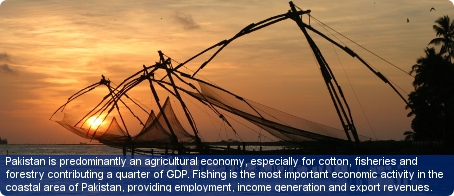Find a business in Pakistan

Pakistan has a predominantly agricultural economy. It has a GNI per capita of US$1,260 (2012) but has seen GDP growth of 2.6% per annum (2008-12). As well as agriculture (notably cotton), fisheries and forestry, Pakistan does have large deposits of natural gas and after the October 1999 coup, privatisation and the development of a computer software industry was encouraged. However, the country is vulnerable to natural disasters and floods in July 2010 caused widespread disruption to economic activity across the country.
Agriculture together with forestry and fisheries contributed to around 21% of GDP in 2010. Agriculture is a fundamental component of the Pakistani economy – it provides over 45% of the population with employment. Agriculture is largely small scale, so increased mechanisation is necessary to facilitate growth in the sector. Cotton alone contributed 1.4% of GDP in 2010, which amounted to a total production of 12.9 million bales.
Livestock farming is an increasingly large industry in Pakistan, and the country is now the world’s fourth largest milk producer. The pastoral sector is moving from subsistence farming to a large industry, and now accounts for 11.5% of GDP (2011). The main products in this sector are milk and meat, whilst poultry production has emerged as an important addition to this profile.
Pakistan has reserves of both oil and gas. In 2011 there were 313 million barrels of proven oil reserves and 840.2 billion cubic metres of proven natural gas reserves (January, 2011 estimate); oil production was running at 65,000 barrels per day and gas production at around 4 billion cubic feet per day. There are seven refineries operating in the country, with capacity of 13 million tonnes per year. Although Pakistan produces oil, it relies on imports to meet its demand.
The manufacturing sector contributes around 20% of Pakistan’s GDP (2008). The major products manufactured in Pakistan are: chemicals, textiles, machinery, tobacco and agri-products. The textiles industry is the largest sub-sector, which provides 10% of GDP. Pakistan exported textiles worth US$7 billion in 2009.
However, there are serious problems faced by the manufacturing industry, the foremost of which is unstable electricity provision. As well as this, the severe flooding of 2010 seriously damaged industrial output. Despite these challenges, this sector has started to grow again since December 2010, and between 2010 and 2011 the sector grew 3%.
The country has been wracked by decades of internal disputes, three wars (1947, 1965 and 1971) and decades of costly ongoing tensions over the disputed Kashmir province (with neighbouring India) and almost three decades of fighting in neighbouring Afghanistan. Pakistan has suffered from low levels of foreign investment, most likely resulting from these intermittent periods of instability.
After years of strong growth, the economy stalled in the late 1990s when Pakistan found itself burdened with a rapidly increasing balance of trade deficit and very large external debts. The government has made substantial macroeconomic reforms since 2000, most notably privatising the banking sector. Poverty levels have decreased since 2001, and Islamabad has steadily raised development spending in recent years.
Road transport provides the backbone around which Pakistan’s freight and passenger services operate. Both Pakistan’s road and rail services predominantly run along a north-south axis, providing the ports in the south west of the country with goods produced in Pakistan’s primary production centres further north.
Pakistan is ranked as the 29th best country in the world for protecting investors, according to the World Bank’s ‘Doing Business 2012’ study. The country is ranked 105th overall for the ease of doing business but third best in the South Asian region for the same category. These rankings measure the conduciveness of a regulatory regime in starting and operating a business.
Pakistan has an adult literacy rate of 54.7% (2011), and most of the population are familiar with the official languages, Urdu and English. The composition of Pakistan’s workforce mirrors the composition of its industries, the major player being agriculture.



